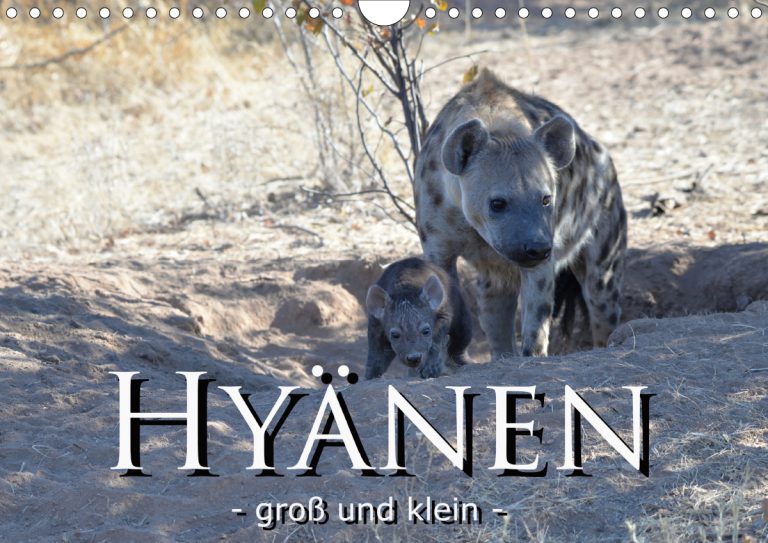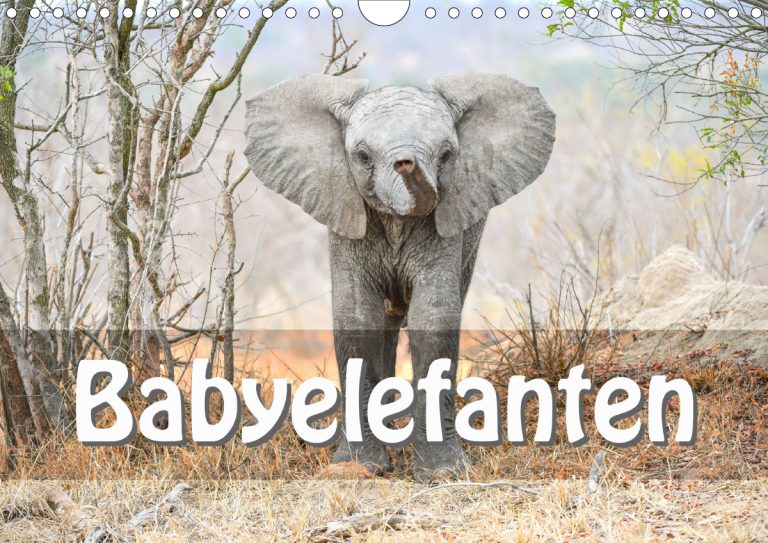Travel Report Ranthambore, part of a 13 days round trip through Rajasthan (India)
What highlights are there to discover in Ranthambore? What is a must-see?
The main reason for our round trip to India was the desire to photograph wild tigers. Ranthambore is still one of the best places in India for this and the best time to visit is between November and mid-December if you want to avoid the really hot temperatures. But if you don’t mind the heat, you can also choose January or February, where temperatures often exceed 40 degrees,
Where is Ranthambore in India?
What you should definitely think about when traveling to Ranthambore
Local currency: Indian rupee (INR). You can use your credit card everywhere for payments or cash withdrawals. Cash is mainly needed for tips.
Vaccinations: No vaccinations are required if you are coming from Germany. However, it is advisable to see a doctor before your trip to have your vaccinations checked and to have a number of vaccinations, such as rabies, carried out. Any doctor can provide more detailed information or, if necessary, the Tropical Institute.
Visas: German citizens require a visa for India. The visa must be applied for at an Indian diplomatic mission or as an e-visa before entering the country. Visas on arrival are not possible. Here is the Link to the official Website for Visa.
As always, there are a number of websites that will apply for a visa for a fee. For people with a good knowledge of English, the Indian website is not a problem. As a rule, you need a 30-day tourist visa. This costs just under 30 USD including all fees. You can only apply for the visa 30 days before entry and it is then valid for 30 days from entry.
Taking a drone to Ranthambore National Park (in India), is that allowed?
The short answer is NO. In India, Indians are allowed to have and fly drones, but it is almost impossible for tourists to get a drone permit. If you still want to try – without a permit – you should have a look at Indian prisons or visit one of the many websites where you can try to apply for a permit. Neither is nice.
Detailed travel report Ranthambore - important questions:
Is Ranthambore cheap?
Hotel prices in Ranthambore are not really cheap if you want a certain European standard. A safari is expensive, although not quite at the level of African safaris. For your own jeep, driver, guide, entrance fee, accommodation and meals, you should budget a minimum of 750-1000 euros per day for 2 people.
The highlight in Ranthambore is the national park - experience tigers and many other animals in the wild
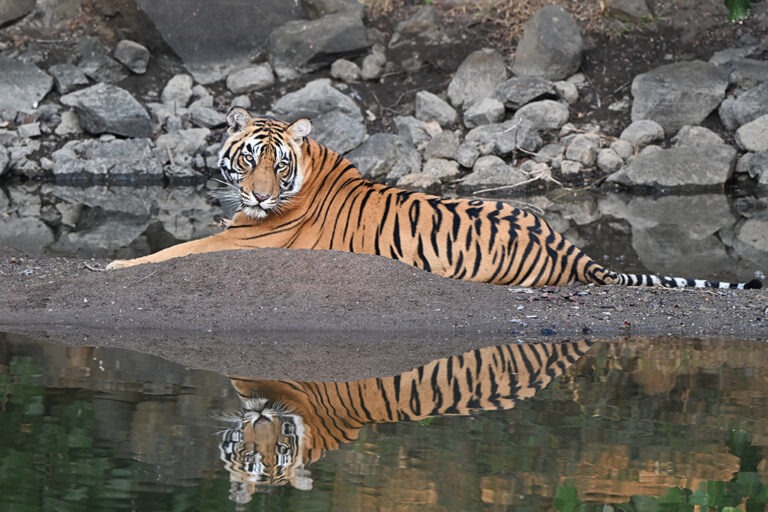
The nearest airport is Jaipur. However, as you usually land in Delhi, it is not worth taking an onward flight, as there is hardly any advantage in terms of time. It is better to drive directly from Delhi to Ranthambore, which takes about 5.5 hours. You can also combine this part with a visit to the world-famous Taj Mahal, see our other travel report, and then continue from Ranthambore to Jaipur (approx. 3h drive) – see Jaipur travel report.
The Ranthambore National Park is famous for its tigers, but also for its biodiversity, from sloth bears to axis deer, kingfishers and crocodiles.
Should I hire a car and drive to Ranthambore myself?
Our recommendation is definitely NO. Driving in India is definitely not for Europeans and is far too dangerous. The Indian way of driving has nothing to do with the way we are used to in Europe or the USA. In addition, you can book a driver with a car (preferably an SUV) for very little money and he will drive you around the whole time. Many hotels also offer this service. That’s why you should do without a rental car if at all possible.
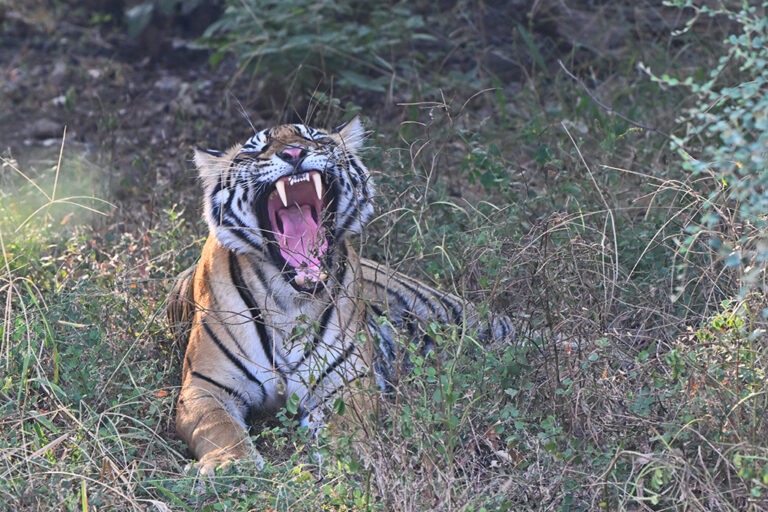
Ranthambore, how can you integrate it into a round trip?
Routing
1.Day: We flew directly to Delhi from Germany
Hotel: Aloft New Delhi Aerocity, 5B IGI T3 Road, Delhi Aerocity New Delhi, 110037
2.Day: Delhi – Agra (Taj Mahal) Transfer with an AC Innova: Travel time approx. 4 hours.
Hotel: ITC Mughal, a luxury collection, Taj Ganj, Agra, 282001
3.Day: Departure to Ranthambore, travel time approx. 6 hours (!). 300km
Hotel: The Ranthambhore Bagh, Village Khilchipur, Off Ranthambhore Road, Sawai Madhopur 322001,
4.-7.Day: Tiger safari in Ranthambore National Park, 7 safari drives in total
8.-9.Day: Departure to Jaipur, driving time approx. 3:30h. Approx. 160km.
Hotel: ITC Rajputana, a Luxury Collection Hotel, Jaipur, Palace Road, Jaipur, 302006 India
10.-11.Day: Transfer to the airport, flight Jaipur (T2) with Indigo to Jodhpur
Hotel: The Ajit Bhawan – A Palace Resort, Near Circuit House Road, Jodhpur, 342006 Transfer from the airport to the hotel organized with the hotel (!)
11.-13.Day: Transfer to Udaipur organized by hotel (12k INR + Tax), Innova AC. Travel time approx. 5:30h (!) . ca 260km.
Hotel: Moustache Udaipur Luxuria, 25-26 Navghat, Next to City Palace,
Udaipur – 313001,Rajasthan
13.Day: Transfer to the airport organized by the hotel. Flight Udaipur with Indigo to Delhi. Visit Delhi city, then return to the airport.
Due to the early return flight (01:50 am), we booked another hotel room on the last day to rest before our departure.
Hotel (again):Aloft New Delhi Aerocity, 5B IGI T3 Road, Delhi Aerocity New Delhi, 110037
Ranthambore National Park - Tiger Safari
We planned the entire trip around the tiger safari as a highlight and made friends with a photographer (Aditya “Dicky” Singh). He and his family were very helpful with the organization. They run a travel agency and also an accommodation in Ranthambore “The Ranthambore Bagh”. We therefore decided to book the safari, the journey to and from Ranthambore National Park and the accommodation with Aditya and his wife Poonam. They are photographers themselves and specialize in photographers. The new accommodation was only completed and opened in December 2022. Previously it was a tented camp, now it is a real hideaway. Unfortunately, Aditya died of a heart attack shortly before our trip at the age of just 57 (06.09.2023 RIP “Dicky”).
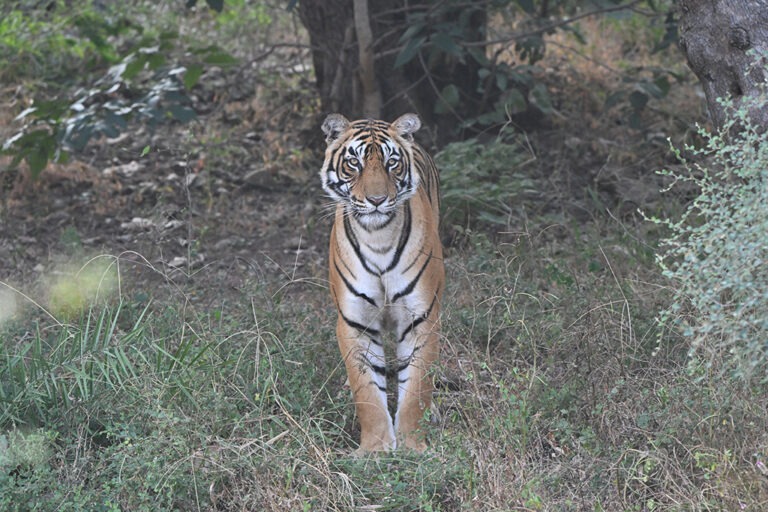
The accommodation Ranthambore Bagh
The accommodation is new (opened in 2022) and very nicely done. Everything is in top condition and you immediately feel at home, not least because of the extremely friendly staff.
For Europeans, however, the beds take a little getting used to, as there is no proper slatted frame and the mattresses are thin and very hard. After the rather strenuous safari drives, you won’t find much rest for your back here, which is a shame, as the accommodation is a little gem close to the park.
If you want a daily cleaning service and the beds made, you have to book this. Apart from that, there is really nothing missing. All rooms are equipped with air conditioning, a fan, an en-suite bathroom and a small outdoor area.
The meals are all excellent – 5 stars for the cuisine – and the gin and tonics in the evening help you to get a good night’s sleep and forget the hard bed.
The charging options for cell phone, camera etc. are up to date in the lodge, so you can easily charge your devices at night. Wifi is available free of charge throughout the lodge.
The Tigers of Ranthambore - Zone 4
Departure from Ranthambore Bagh is at 6 a.m., preceded by tea, coffee and cookies. The small safari jeeps are from Maruti (a cooperation with Suzuki) and offer space for 4-6 people. However, we recommend an exclusive booking for 2, as everything else is too cramped. Our guide is Rajkuman, a close associate of Dicky and also specializes in photography.
It takes just under 10 minutes to get to the park. You first pass the main entrance, where you are immediately surrounded by local traders offering you all kinds of goods for the safari (hut, cloths etc.), then you continue for about 3 km through a gate before you reach the entrance gates to the individual zones, at least as far as zones 1-5 are concerned. For zones 6-10, the entrance is about 15km away from Ranthambore Bagh.
The zones are determined at the time of booking and it is on a first come, first served basis, which is why the best zones (with the highest chance of seeing tigers) are usually well booked or fully booked 1 year in advance.
We start in zone 4. 7 Maruti Gipsy Jeeps (yes, this is also fixed) and seven trucks, so-called Kanters (also Maruti) for larger groups are permitted per zone. So a total of 14 vehicles per zone.
The zones themselves are relatively large, but the choice of routes is not. Off-road driving is not allowed and there is usually only one way in and out of the zones, if you are lucky a ring road. Zone 4 is a very nice area. The paths are reasonably good, there are a few lakes and streams and the vegetation is not too dense.
After about 1 hour we see our first tiger. The feeling is incredible. The tigers feel a lot bigger than lions, although the difference in direct comparison is probably not that big. But tigers are the biggest of all big cats. In Ranthambore, you only see Bengal tigers and according to our guide, there are now around 100 animals again, after there were only 18 left in the park in 2015 due to poaching.
The park is also home to axis deer (which have white spots in their fur) and sambar deer, which are similar to our red deer but appear slightly larger and darker.
There are also some antelopes and then of course there are the monkeys. The birdlife is also impressive and you can spot some species that you have never seen in Europe.
You shouldn’t have anything edible in the car, at least not openly, as both the monkeys and the birds recognize this very quickly and then become quite “trusting”, which you should avoid, especially as it is also strictly forbidden.
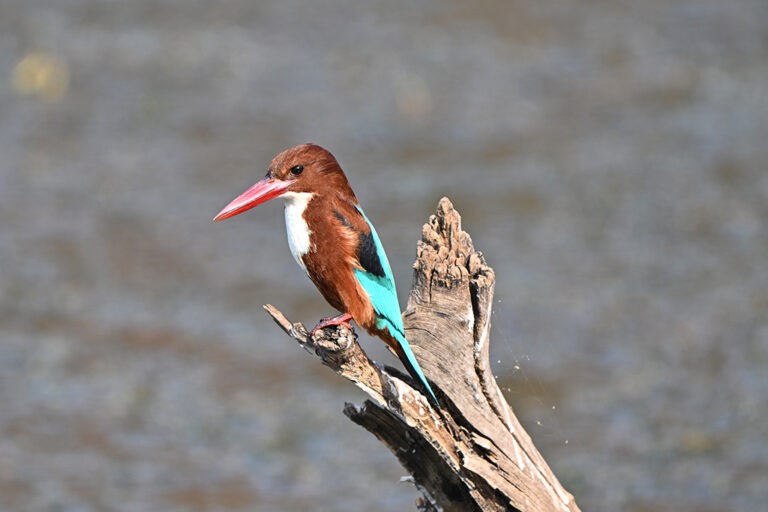
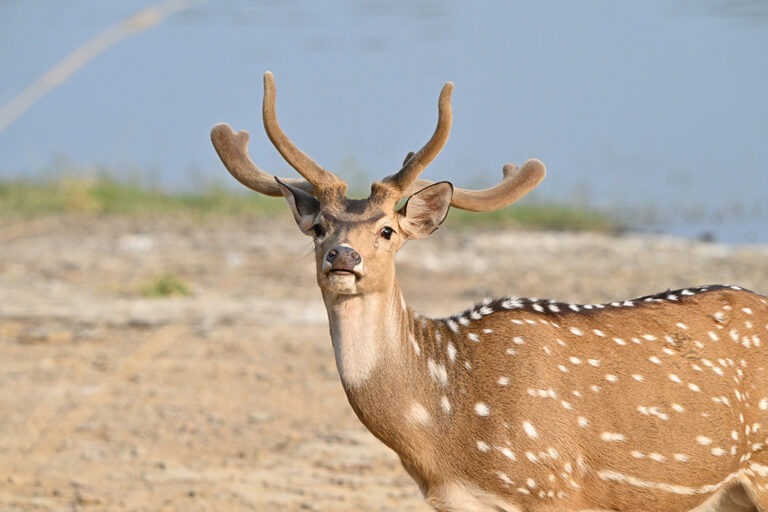
Safari times in Ranthambore National Park
As mentioned at the beginning, the best times for safari in Ranthambore are November to mid-December and January and February.
The safari times until October 31st are from 06:30 to 10 am (morning) and from 2:30 to 6 pm (afternoon). You have a good 3.5 hours to yourself between the drives (some time is left for arrival and departure). The times in the park are always fully utilized and strictly controlled.
The times change from November 1st. It only starts at 07:00 and continues until 10:30 and then in the afternoon from 14:00 to 17:30. In our case, pick-up always took place 30 minutes earlier, so that the time between the drives was reduced to 2.5 hours.
Unlike what we know from southern Africa (Namibia, South Africa, Botswana, Zimbabwe), the drives here are not interrupted by a breakfast break or a sundowner. However, there is a place with toilets in each zone, which is stopped at about half-time. Otherwise there are no stops. Also unlike in Africa, you are allowed to stand up in the jeep during a sighting. This is perfectly fine and is used by many people.
The tigers of Zone 2
Our second drive in the afternoon takes us to Zone 2, which is completely different from Zone 4. You feel more like you’re in the world of “The Jungle Book”. Ruined temples, banjan trees and lots of dense bushes. We are lucky again here and see a tiger, but not as relaxed and calm as in Zone 4. The tiger here moves quite quickly through the forest. Still, a nice moment.
While it is fresh and pleasant in the morning (a fleece and a light jacket as well as a cap or baseball cap are sufficient at this time), it is hot in the afternoon. Over 30 degrees is not uncommon. You should apply plenty of cream and wear light clothing.
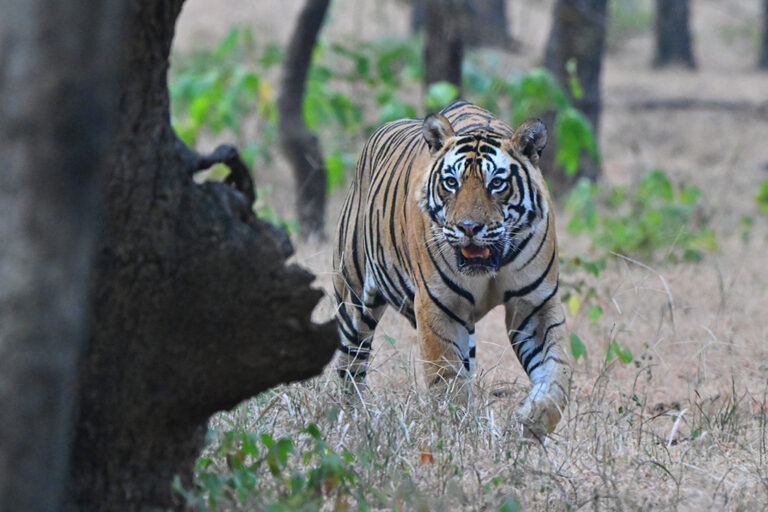
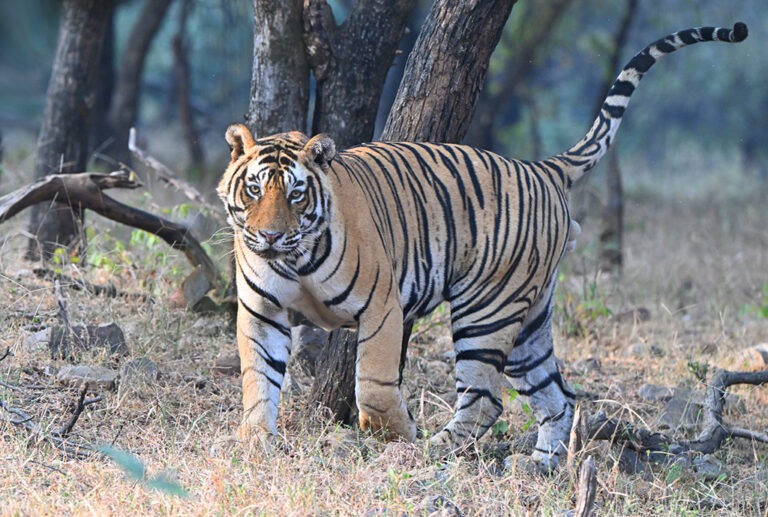
Dust - the enemy of every photographer in Ranthambore
Let’s move on to one of the most important topics for photographers, the protection of equipment. If anyone is wondering where exactly dust was invented, it is clearly Ranthambore National Park. Fortunately, the dust is so fine that it can easily be knocked off or blown away with a blower. Unfortunately, it is so fine that it finds its way everywhere. For this reason, 2 things are important;
1, never get the idea of changing the lens in the park, unless you want to take the camera directly to a service center later.
2. transport the camera and lens in a large dustproof bag or sack. A large plastic bag also works well.
The equipment should be checked and cleaned after every trip. We have been to a lot of places with dust etc., but Ranthambore was definitely the dustiest place so far.
After cleaning your equipment, you shouldn’t be surprised if the water turns slightly brownish when you shower, as the dust also sticks to you. If you are sensitive, you should pack a mask for the rides or tie a cloth over your mouth and nose, which many guides do.
The Tigers of Zone 1
Again, completely different vegetation, with lots of mountains, rivers and lakes. We see a sloth bear right at the entrance. They look like black bears, but seem a bit bigger to us. The rest of the morning is rather unspectacular, although the landscape is very beautiful.
On the way back, we come across hundreds of beautifully dressed women who are all walking to Ranthambore Fort, which can also be reached via the main road in the park. They celebrate there every Wednesday, but Nov. 1 is a special day. The women fast from sunrise to moonrise and walk to Ranthambore Fort, which is incredibly tiring in the heat.
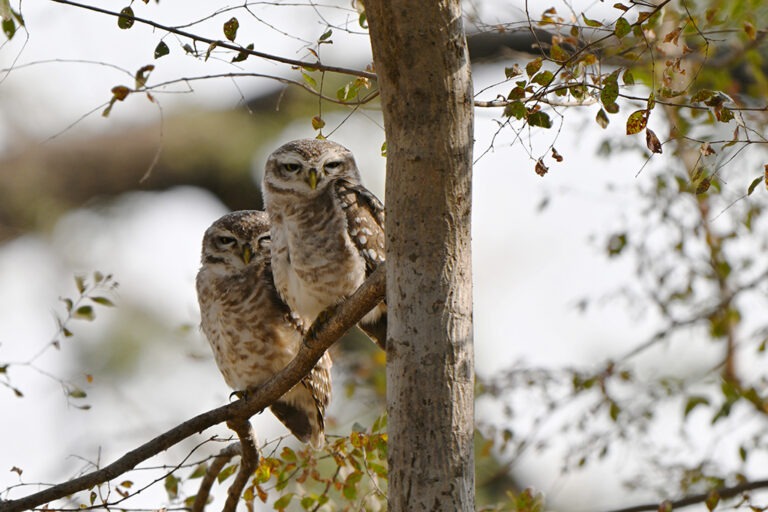
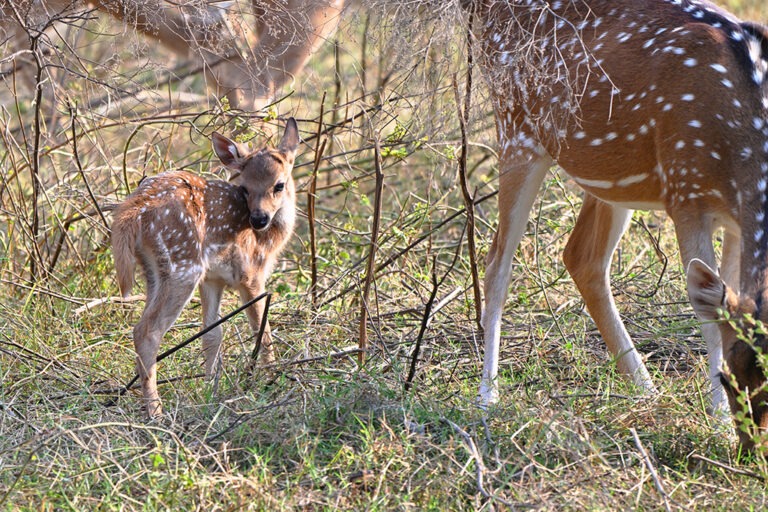
The tigers of zones 4 and 5
We were lucky with our booking and were able to see Zone 4 twice. Zone 4 is one of the largest and, for us, most beautiful zones. At the beginning of November it is still 30-35 degrees during the day. It is therefore already very warm in the safari cars and you should think about good sun protection.
After 2 hours, in which there was little to see, we were lucky enough to see 2 tigers. Male and female, but siblings.
Due to the heat and strong sun, the tigers tend to stay in the shade, which means that you have to take photos with a high ISO.
In addition, the tigers are rarely as close to the vehicle as e.g. lions in Africa, so that focal lengths of 300mm and more are necessary, which in combination with the high ISO has an effect on the image quality. But no matter, the experience of seeing a tiger in the wild is priceless.
Zone 5 is one of the best zones for tiger sightings and you should try to get it several times. We also had the best sighting ever here and were able to observe a large tiger for almost 2 hours continuously.
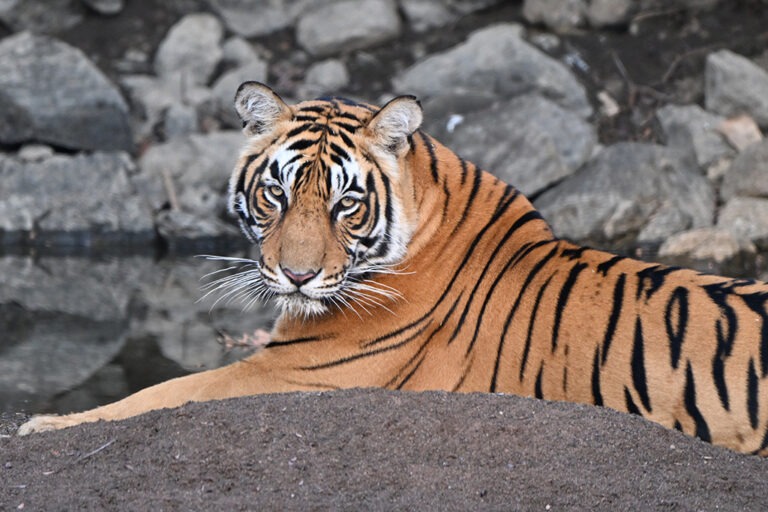
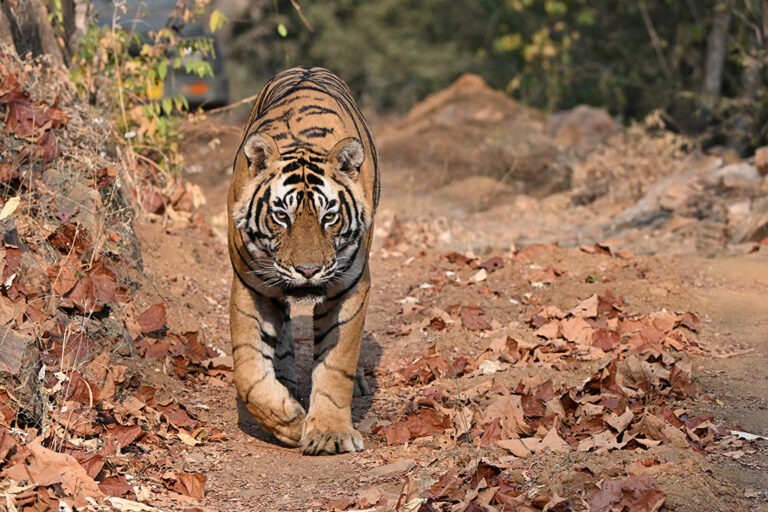
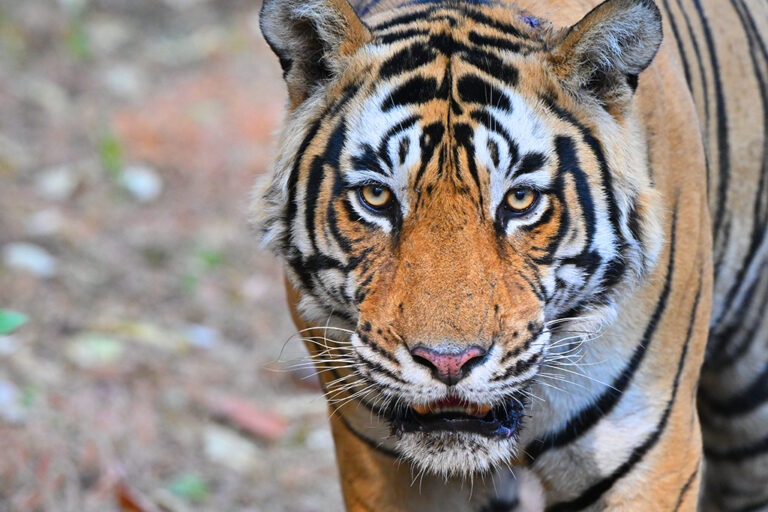
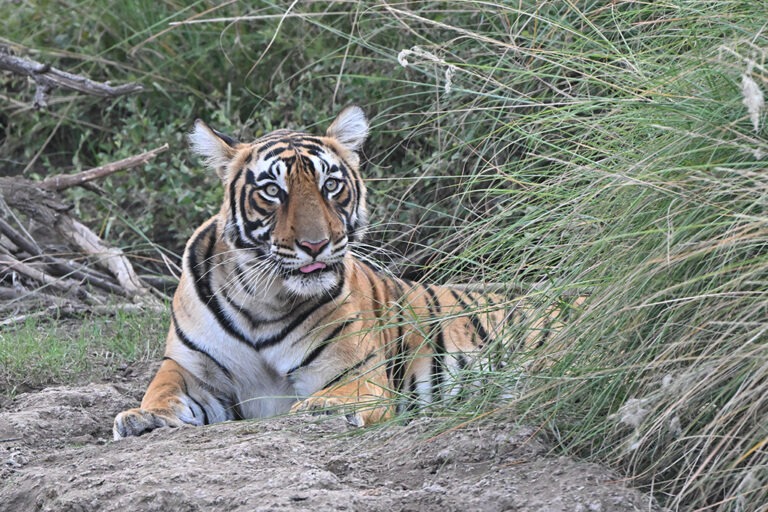
The Tigers of Zone 3
Zone 3 is definitely the most attractive in terms of scenery and the most pleasant to drive. Zone 3 is the territory of a female, who often raises young here. Unfortunately, we didn’t get to see her.
What lenses should you have with you? Something up to 600mm focal length is ideal, 400mm should be at least and preferably a zoom, as you should be flexible in the park. If no zoom is possible, then no more than 400mm. In the end, we didn’t use short focal lengths of less than 200mm, as you can simply use your cell phone, which is no problem at all, especially for videos.
The lighting conditions in October November are rather difficult. The light is great, but the contrasts in the park between light and dark are enormous, which is why we ended up opting for Auto ISO. To enable fast shutter speeds, the ISO then goes up very quickly to 4000+ for photos. For video, on the other hand, where you are usually shooting at 1/60, ISO is not a problem.
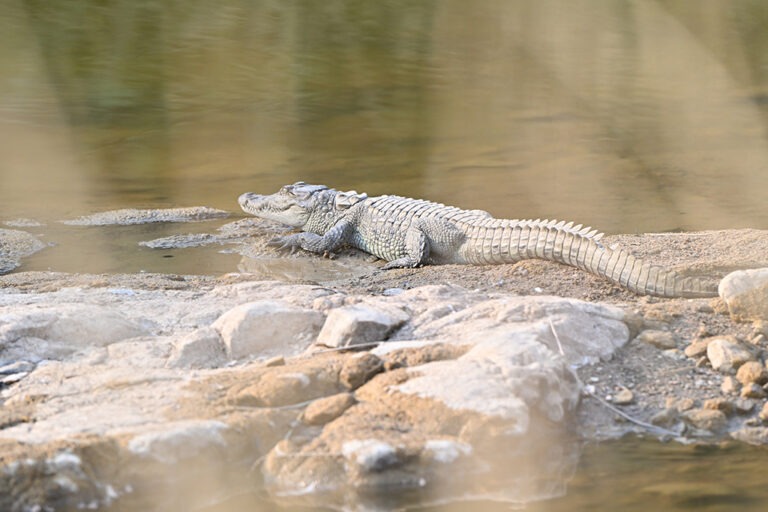
Fazit
Ranthambore is well worth a visit and we will be back sometime. The people are welcoming, our guide Rajkumar was absolutely top class and the tiger sightings were unique. We are aware of how lucky we were. We saw tigers on 5 out of 7 safari drives. Many visitors who only come for one day see nothing. You should book at least 3 days safari to have a good chance of sighting. Unlike in Africa, the guides here are not connected by radio and so it is a game of chance every time to see a tiger. But once you have found one, you often have it to yourself.
After three and a half days on safari, it was clear to us which zones we liked best (in this order): 5, 3, 4, 2, 1.
5 and 3 are definitely the best, closely followed by 4.
We would try to leave out 2 and 1 next time. Another consideration is to skip the afternoon trips, at least in November, as the sightings in the afternoons were less spectacular. This is because the tours start at 1:30 in November and admission to the park is from 2 pm to 5:30 pm, so it’s just too hot. But on the other hand, you’re happy just to drive through the park, or to be driven through it.
Calendar from our Phototours online?
Which photo equipment for Ranthambore in India?
The photographic equipment we took with us to Ranthambore is listed below. You also have the option of ordering the photographic equipment we used directly via our Photo-Shop and requesting further technical details. There are also lots of extras available there.
Cameras:
- Z8 (Nikon)
- Z7ii (Nikon)
- Apple Iphone 14pro
- Go Pro Hero 8
Lenses:
- Z 24-120mm f/4 (Nikon)
- Z 70-200mm f/2.8 (Nikon)
- Z 180-600mm f/5.6-6.3 (Nikon)

